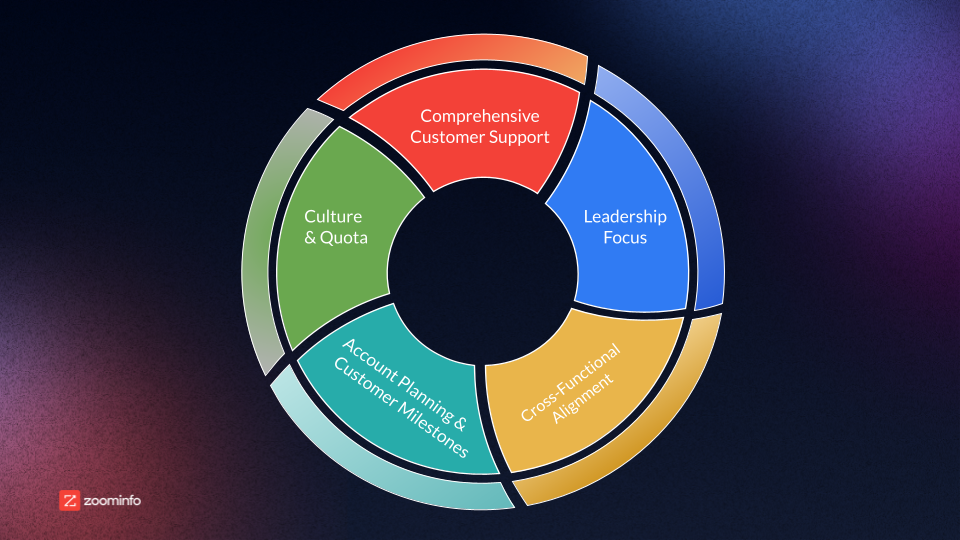We’ve all heard the adage that it can cost five times more to land a new customer than it does to maintain an existing one. For many B2B go-to-market teams, this rings true — as long as it’s the right customer.
Sustainable revenue growth comes when you engage with the best-fit accounts that have the potential to grow over time. And growing a customer account takes special care.
Try to remember the best experience you’ve ever had as a customer. What made it stand out? Maybe the sales team you worked with was attentive, maybe you got the support you needed, or maybe the solution exceeded your expectations. And did you find yourself feeling more connected to the brand because of that experience?
Now think about your worst customer experience. Maybe the salesperson was unprofessional or you thought you’d receive more guidance. Maybe the product didn’t perform the way you hoped. Were you likely to stay put or bounce?
When it comes to customer satisfaction, each step in the experience matters. How your customers feel at every stage of the buyer’s journey affects whether they renew or expand their contract.
Here are five key components to consider when planning your customer renewal and expansion strategy.
5 Components of a World-Class Revenue and Growth Team

1. Comprehensive Customer Support
There’s no “I” in “team.” Whether you’re operating a small business or a global enterprise, having enough account managers and customer success managers (CSMs) to support your customers’ is non-negotiable.
That means it’s important to pace yourself when you enter a new market. You don’t want to onboard more accounts than you can reasonably support, so be sure to staff up accordingly. And if you’re serving international accounts, consider hiring CSMs in the local markets to increase familiarity and culture fit.
You should view the relationship with your customers as a partnership, rather than a business exchange. A successful partnership is built on trust, communication, and support, which is more than simply closing a sale.
It’s also important to look at the number of accounts you have in each customer segment (small business, mid-market, enterprise). Focus on keeping your current customers happy and building these partnerships. Once you’ve achieved success with your existing accounts, it’s much easier to think strategically and build your team for the next market.
2. Leadership Adjustments and Focus
As your business grows, it’s important to dedicate focus and attention to each customer segment. Don’t treat all customers the same: building trust and rapport with small business owners can look a lot different than with mid-sized or enterprise customers. The selling motions, timelines, messages, and players involved can also be vastly different.
Small businesses tend to need:
More structure
Better discipline
The ability to move quickly
Enterprise customers tend to need:
Greater engagement
Deeper account insights
More features and functionalities
When you establish clear goals within each customer segment, each individual leader can create personalized sales strategies with their teams. Continue to make adjustments to keep your teams focused on meeting each account’s unique needs.
3. Alignment of Sales and Success Teams
The two halves of the customer experience — account management and customer success — are vital to growth and retention. Account managers establish long-term milestones to expand the business, while CSMs support customers’ day-to-day needs and adoption.
These two teams must strive to work in harmony. This means that the customer receives a cohesive experience regardless of their request — whether it’s asking about how to troubleshoot a product feature or purchasing more seats.
From a customer’s point of view, your two separate teams should function as one and the message should be the same. The closer these two teams collaborate, the better the results.
Customer experience can even be a bigger differentiator between competitors than their product features. You build trust with your customer by delivering a predictable, reliable, and successful experience. Then, when it comes time to renew, their decision becomes much easier.
4. Account Planning and Milestones
One of the most important aspects of optimizing customer value is putting in place a clear account plan, including regular milestones. By establishing a timeline of goals to achieve for each customer, your team can stay proactive and aligned, and continually highlight value to your customer.
Here’s an example of three milestones for a customer account:
Milestone 1: Kickoff Call The customer is successfully onboarded and transitioned to the Customer Success and Account Management teams for a kickoff call.
Milestone 2: Strategic Review Meeting Six months into the contract, there is a strategic business review meeting to document progress and identify areas of future growth. This is also an opportunity to start talking about the renewal process and underline how the customer can continue to unlock value within your platform.
Milestone 3: Review Results Nine months into the contract is a good time to review the results achieved. Compare them against baseline measurements from before onboarding, to prove the value and ROI of your solution.
Milestone 4: Contract Renewal By delivering consistent customer value, the renewal should be a no-brainer for the customer.
5. A Culture of Quota-Crushing
Sales leaders are driven by metrics, performance, and success — but it all begins with people. Your team is on the front lines, so understanding what keeps them motivated, engaged, and feeling supported is critical to delivering excellent customer experience.
Most account management teams rely on data to pave the way. In particular, key performance indicators (KPIs) can make the process of tracking progress much easier for everyone. By establishing KPIs, you’re encouraging your team to take control of their own success. Being able to see what each deal means in terms of quota for individual reps is important. This ensures that they can see their achievements, how much they have left to do, and ultimately, what they’ll earn.
You’ll also cultivate ownership, pride, and performance among your team. About three-quarters of employees report they are more effective at their job when they feel heard. It’s critical to build unity across your sales team to promote personal growth and achieve goals.
At ZoomInfo, we strive to be 1% better every day. This goal guides our day-to-day work. As long as you strive to be 1% better, you’re bound to see far greater success over time.
Our team believes in:
Having mutual respect for one another.
Creating an environment where reps are encouraged to learn continually.
Picking each other up when we fall down.
When reps feel supported to achieve their goals, it has a downstream effect on the entire customer experience. Motivated teammates want to deliver a great experience in order to maintain and expand accounts — it’s a win-win situation.


